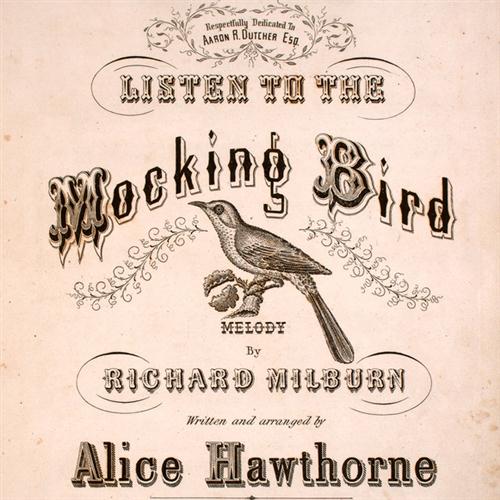 | Listen to the Mocking Bird (aka “The Mocking Bird”)Septimus Winner as Alice Hawthorne (words), Richard Milburn (music) |
Writer(s): Septimus Winner as Alice Hawthorne (words), Richard Milburn (music) (see lyrics here) Published: 1855 First Charted: August 22, 1891 (John Yorke Atlee) Peak: 16 US (Atlee) (Click for codes to charts.) Sales (in millions): 20.0 (sheet music) Airplay/Streaming (in millions): -- radio, 0.38 video, -- streaming |
Awards: (Winner/Milburn)Click on award for more details. Awards (John Yorke Atlee):Awards (Frank Stanley): |
About the Song:Septimus Winner, a Philadelphia songwriter, music teacher, publisher, and music store propietor, was inspired to write this tune in 1855 after hearing Richard “Whistling Dick” Milburn. The African American barber busked on the streets of Philadelphia, playing guitar and whistling. He sometimes imitated a mockingbird. Winner added lyrics about a narrator mourning the loss of his beloved Hally. He visits her grave and hears a mockingbird singing, which they often did when she was alive. JM Soon after he published the song, Winner sold the copyright for five dollars, missing out on a huge windfall. Milburn, meanwhile, reportedly only received 20 copies of the song as payment SF and his name was later removed from the credits. In the early 20th century, a Philadelphia newspaper estimated that the song had sold 20 million copies of sheet music in America and Europe. JM That figure, however, has never been verified and is assumed to be wildly exaggerated. SS In Yesterdays: Popular Song in America, Charles Hamm asserts that “Mocking Bird” was significant in popularizing the verse-chorus structure that would become nearly universal in popular music. SS Among the song’s fans were King Edward VII of England, who said he whistled the song as a boy, and Abraham Lincoln who called it “a real song…as sincere and sweet as the laughter of a little girl at play.” JM The cover of the sheet music calls the song “a sentimental Ethiopian ballad.” TY2 John Yorke Atlee, who was known as “the Artistic Whistler,” had the first charting version of the song in 1891, taking it to #1. It charted three more times, peaking at #3 each time. Joe Belmont did the trick in 1899, Frank Stanley with Corrine Morgan in 1904, and Alma Gluck in 1915. PM The verse of the song was used as an instrumental introduction to short films by the Three Stooges. WK It has also been used in TV cartoons Heckle and Jeckle, The Flintstones, and SpongeBob SquarePants. WK Resources:
First posted 4/15/2021; last updated 9/2/2023. |








I did not even know 20 million phonographs could exist in such a time period.
ReplyDeleteAs stated in the post, it is estimated that 20 million copies of the sheet music sold, not 20 million copies of the recording. Even then, it is also noted in the post that it is suspected that this number is exaggerated.
Delete